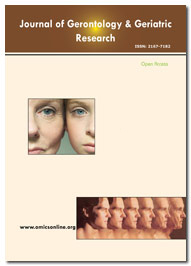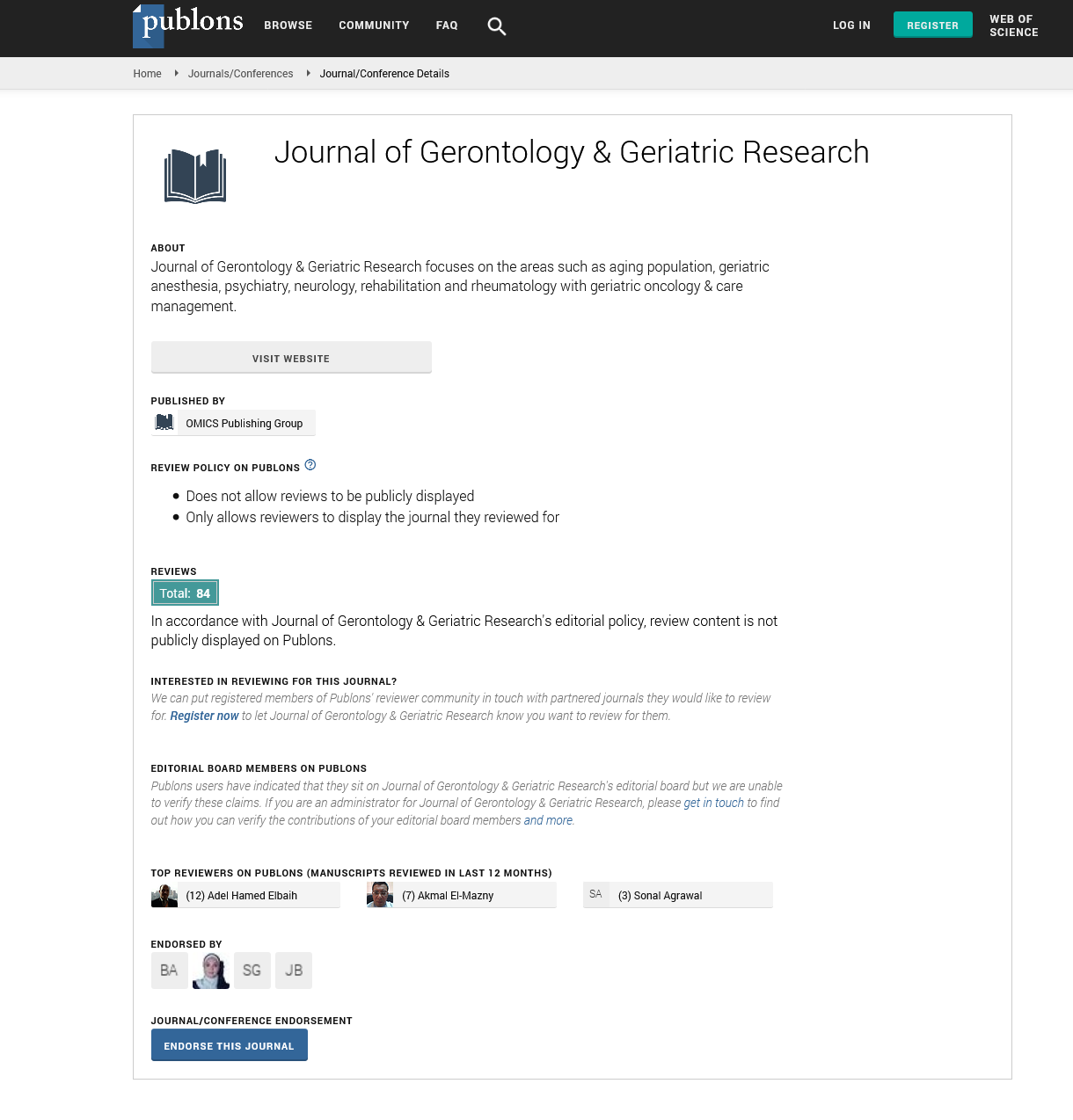Indexed In
- Open J Gate
- Genamics JournalSeek
- SafetyLit
- RefSeek
- Hamdard University
- EBSCO A-Z
- OCLC- WorldCat
- Publons
- Geneva Foundation for Medical Education and Research
- Euro Pub
- Google Scholar
Useful Links
Share This Page
Journal Flyer

Open Access Journals
- Agri and Aquaculture
- Biochemistry
- Bioinformatics & Systems Biology
- Business & Management
- Chemistry
- Clinical Sciences
- Engineering
- Food & Nutrition
- General Science
- Genetics & Molecular Biology
- Immunology & Microbiology
- Medical Sciences
- Neuroscience & Psychology
- Nursing & Health Care
- Pharmaceutical Sciences
Opinion - (2024) Volume 13, Issue 5
Falls Prevention and Rehabilitation: Evidence-Based Practices in Older Adults
Atun Shen*Received: 02-Oct-2024, Manuscript No. jggr-24-27665; Editor assigned: 04-Oct-2024, Pre QC No. P-27665; Reviewed: 17-Oct-2024, QC No. Q-27665; Revised: 23-Oct-2024, Manuscript No. R-27665; Published: 30-Oct-2024, DOI: 10.35248/2167-7182.2024.13.755
Introduction
Falls among older adults are a significant public health concern worldwide, with profound consequences that can severely impact an individual’s health, mobility, and quality of life. In fact, falls are the leading cause of injury-related hospitalizations and fatalities among older adults, and their incidence increases as the population ages. According to the World Health Organization (WHO), approximately one in three people aged 65 and older experience a fall each year, with many suffering from broken bones, head trauma, or long-term disability. The fear of falling itself can lead to a decline in physical activity and social isolation, further exacerbating the risk of subsequent falls. As the global population of older adults continues to grow, addressing the issue of falls prevention and rehabilitation has become increasingly urgent [1].
This article aims to explore evidence-based practices for fall prevention and rehabilitation, specifically tailored to the needs of older adults. We will focus on understanding the multifactorial nature of falls, effective strategies for preventing falls, and the evidence behind rehabilitation interventions that can help older individuals recover and regain their independence after a fall. Additionally, we will highlight the critical role of healthcare professionals, caregivers, and the wider community in promoting safety and supporting older adults through their recovery journey.
Description
To develop effective prevention and rehabilitation strategies, it is essential first to understand the various risk factors that contribute to falls among older adults. These risk factors can be classified as intrinsic (internal to the individual) and extrinsic (external environmental factors). Intrinsic risk factors include age-related changes in balance, strength, vision, and cognitive function, as well as chronic conditions such as osteoporosis, arthritis, diabetes, and neurological disorders like Parkinson’s disease. For instance, muscle weakness and reduced joint flexibility are common as people age, making it more difficult to maintain balance and stability. Similarly, vision problems, such as cataracts or macular degeneration, can significantly impair depth perception and reaction time, increasing the risk of tripping or losing balance [2].
Cognitive decline, particularly in conditions like dementia or Alzheimer’s disease, can also impair an individual's ability to assess environmental hazards or remember to use mobility aids properly. Extrinsic factors play a critical role in fall prevention as well. Environmental hazards such as slippery floors, uneven sidewalks, poor lighting, and cluttered living spaces can all contribute to falls. Inadequate footwear or poorly maintained assistive devices, like canes or walkers, further increase the likelihood of a fall. Additionally, medications—especially when multiple prescriptions are involved—can cause dizziness, drowsiness, or hypotension, which can lead to falls. Polypharmacy is particularly concerning for older adults, as the combined effects of multiple drugs may interact in unpredictable ways. By understanding these risk factors, healthcare providers can develop personalized care plans that address both the intrinsic and extrinsic causes of falls, providing a more holistic approach to fall prevention.
A successful approach to fall prevention requires addressing both modifiable risk factors and engaging in proactive strategies that reduce the likelihood of falls occurring. Research has shown that a combination of exercise, environmental modifications, medication management, and education can significantly reduce fall risk and improve overall outcomes for older adults. One of the most effective strategies for preventing falls is exercise, particularly programs designed to enhance strength, balance, and flexibility. Regular physical activity, such as tai chi, balance training, and resistance exercises, has been shown to reduce the risk of falls by improving lower limb strength, stability, and coordination. For example, tai chi, which combines slow, controlled movements and deep breathing, has been found to improve balance and reduce the risk of falls in older adults by promoting body awareness and joint flexibility. Balance training exercises, such as standing on one leg or walking heel-to-toe, strengthen the core and lower extremities, which are critical for maintaining postural stability and preventing falls [3].
In addition to exercise, modifying the home environment to reduce fall hazards is another key component of fall prevention. Environmental modifications can include installing grab bars in bathrooms, removing loose rugs or clutter from floors, ensuring adequate lighting in hallways and stairways, and securing cords or wires that might pose tripping hazards. The installation of non-slip mats in bathrooms or showers can also help prevent falls related to wet surfaces. Home visits by occupational therapists or other healthcare providers can be invaluable in identifying specific hazards and recommending modifications tailored to an individual's living situation. Medication management is another crucial aspect of fall prevention.
A thorough medication review should be conducted regularly, especially for older adults who are taking multiple medications. Certain medications, including sedatives, blood pressure medications, and antidepressants, can increase the risk of falls by causing dizziness, low blood pressure, or impairing cognitive function. Reducing polypharmacy by eliminating unnecessary medications and switching to alternatives with fewer side effects can help lower fall risk. Regular monitoring of blood pressure and managing conditions like diabetes or heart disease can also reduce the likelihood of falls caused by sudden dizziness or fainting. Education plays a vital role in fall prevention [4]. Teaching older adults and their caregivers about the risks of falling, proper use of mobility aids, and the importance of maintaining physical activity can empower individuals to take responsibility for their safety. Workshops, pamphlets, and online resources can help increase awareness of fall prevention strategies, while programs like "Stepping On" provide evidence-based education and fall prevention skills to older adults in group settings. These programs typically focus on enhancing knowledge about home safety, physical activity, and how to prevent and respond to falls.
Falls rehabilitation is an essential part of managing the consequences of falls and helping older adults regain their independence. Rehabilitation aims to restore functional mobility, alleviate pain, and improve overall well-being after a fall, particularly when there are injuries such as fractures or sprains. The rehabilitation process is often multidisciplinary, involving various healthcare professionals including physical therapists, occupational therapists, nurses, and physicians, each contributing to the individual’s recovery plan. Physical therapy (PT) is at the core of falls rehabilitation. After a fall, PT focuses on restoring strength, flexibility, and balance, which may have been compromised by the injury. Through targeted exercises, physical therapists help older adults regain mobility, reduce pain, and improve coordination. For example, strengthening exercises for the lower extremities can help support the body’s weight and improve gait.
Flexibility exercises can prevent stiffness and improve range of motion, while balance training exercises teach patients how to correct their posture and maintain equilibrium while walking or standing. Occupational therapy (OT) plays a critical role in helping older adults recovers from falls, especially when injuries impact their ability to perform activities of daily living (ADLs). OT focuses on teaching patients adaptive techniques for dressing, cooking, bathing, and other daily activities. Occupational therapists may also recommend assistive devices, such as reachers, walkers, or modified clothing, to help older adults regain independence. Additionally, OT helps individuals re-engage in social and recreational activities that may have been limited by their fear of falling or physical limitations. Cognitive rehabilitation may also be necessary for patients who have experienced head trauma or other cognitive impairments as a result of their fall.
Rehabilitation following a fall is not only physical but also psychological. Fear of falling again is common among older adults, and it can result in a decrease in physical activity and social isolation, which in turn increases the risk of further falls. Psychological interventions such as cognitive-behavioral therapy (CBT) can help individuals address the emotional impact of their fall, manage anxiety, and increase confidence in their ability to move safely. Additionally, support groups or group therapy sessions provide a sense of community and shared experiences, which can be beneficial for emotional recovery [5]. Furthermore, rehabilitation may involve the use of assistive devices to support mobility during the recovery process. Mobility aids such as canes, walkers, and wheelchairs are essential tools for many older adults who experience limited mobility following a fall. Occupational therapists can help determine which device is most appropriate based on the individual’s needs and capabilities. The goal is to enable the person to move safely and independently while they continue to recover.
Conclusion
Falls among older adults are a significant health challenge that can lead to severe consequences, including injury, disability, and even death. However, evidence-based strategies for falls prevention and rehabilitation have proven to be effective in mitigating these risks and improving outcomes for older adults. Exercise programs, home modifications, medication management, and education are key components of fall prevention, while rehabilitation efforts such as physical therapy, occupational therapy, and psychological support help older adults recover from the physical and emotional impacts of a fall.
Acknowledgement
None.
Conflict of Interest
None.
References
- Tinetti ME. Performance-oriented assessment of mobility problems in the elderly. J Am Geriatr Soc. 1986;36:613-616.
- Park SH. Tools for assessing fall risk in the elderly: A systematic review and meta-analysis. Aging Clin Experim Res. 2018;30:1-6.
- Shany T, Redmond SJ, Marschollek M, Lovell NH. Assessing fall risk using wearable sensors: A practical discussion. Z Gerontol Geriatr. 2012;45.
- Zarulli V, Sopina E, Toffolutti V, Lenart A. Health care system efficiency and life expectancy: A 140-country study. PLoS One. 2021;16:e0253450.
- Thomas SM, Parker A, Fortune J, Mitchell G, Hezam A, Jiang Y, et al. Global evidence on falls and subsequent social isolation in older adults: a scoping review. BMJ Open. 2022;12:e062124.
Google Scholar, Crossref, Indexed at
Google Scholar, Crossref, Indexed at
Google Scholar, Crossref, Indexed at
Google Scholar, Crossref, Indexed at
Citation: Shen A (2024). Falls Prevention and Rehabilitation: Evidence-Based Practices in Older Adults. J Gerontol Geriatr Res. 13: 755.
Copyright: © 2024 Shen A. This is an open-access article distributed under the terms of the Creative Commons Attribution License, which permits unrestricted use, distribution, and reproduction in any medium, provided the original author and source are credited.

